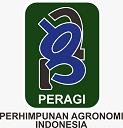Effectiveness of Local Indigenous Rhizobacterial Isolates in Enhancing Resistance of Shallot (Allium cepa L.) to Fusarium oxysporum
Abstract
Fusarium wilt caused by Fusarium oxysporum remains a major limitation in shallot (Allium cepa L.) cultivation, severely reducing yield and crop quality. This study aimed to evaluate the effectiveness of native rhizobacterial isolates as biological inducers of resistance against Fusarium wilt under different organic growing media. A split-plot randomized complete block design was applied using three growing media (rice husk charcoal, manure, and their combination) and four rhizobacterial treatments (control and three local isolates: R1–R3) with three replications. Key physiological assays included the measurement of salicylic acid (SA) content and peroxidase (POX) enzyme activity as biochemical indicators of induced resistance. Results showed that the isolate from Waitii Village (R3) significantly reduced disease incidence to 52.67% compared with 86.56% in the control, while the combined organic medium (M2) further enhanced plant resistance. Increased SA (26.82 ppm) and POX activity exhibited strong negative correlations with disease incidence (R² = 0.60 and R² = 0.71, respectively), indicating their pivotal role in rhizobacteria-mediated defense activation. These findings confirm that indigenous rhizobacteria, when combined with organic amendments, effectively stimulate systemic acquired resistance and mitigate the severity of Fusarium wilt in shallots. The study highlights the potential of the R3 isolate as a sustainable bioinoculant candidate for integrated disease management. Further molecular identification, in vitro antagonism testing, and multi-location field validation are recommended to ensure its stability, efficacy, and applicability under diverse agroecological conditions.
Keywords
Full Text:
PDFReferences
Abna, I. M., Fauzi, E., & Harizal, H. (2023). Pemanfaatan Limbah Batang Pohon Pisang Untuk Produksi Asam Laktat Secara Fermentasi Dengan Variasi Konsentrasi Inokulum Lactobacillus Acidophilus. Journal of Pharmacopolium, 6(1). https://doi.org/10.36465/jop.v6i1.1103
Anggraini, S., Trisno, J., & Tizelia, T. (2020). Potensi Rizobakteri Indigenus Sebagai Agens Biokontrol Jamur Fusarium Oxysporum F. Sp. Cubense Penyebab Penyakit Layu Tanaman Pisang. Jurnal Agroteknologi Dan Pertanian (Juragan), 1(1), 8–16. https://doi.org/10.32767/juragan.v1i1.25
Ariani, R. W., Bahrun, A., Hasid, R., & Sutariati, G. A. K. (2022). Efektivitas Berbagai Agens Hayati Dalam Meningkatkan Pertumbuhan Tanaman Tomat (Lycopersicum Esculentum Mill.). Jurnal Agroteknos, 12(3). https://doi.org/10.56189/ja.v12i3.29456
Budias, F., Udayana, I. G. B., & Wirajaya, A. A. N. M. (2022). Respon Tanaman Bawang Merah (Allium Ascalonicum L.) Terhadap Jarak Tanam Dan Jenis Pupuk Organik. Gema Agro, 27(2), 127–132. https://doi.org/10.22225/ga.27.2.5675.127-132
Hadi, S., Cahyati, A. I., Latif, K. A., Sujaka, T. T., & Zulfikri, M. (2023). Smart Farming System on Red Onion Plants Based on the Internet of Things. Sistemasi, 12(3), 739. https://doi.org/10.32520/stmsi.v12i3.2860
Kamaludin, K., & Wahyuningsih, S. (2021). Analisis Pengelolaan Modal Usaha Dalam Rangka Meningkatkan Taraf Kehidupan Ekonomi Petani Bawang Merah Dengan Menggunakan Media Tanam Sawah Tadah Hujan. Journal of Economic Business and Accounting (Costing), 5(1), 1–12. https://doi.org/10.31539/costing.v5i1.2595
Khaeruni, A., Rahayu, R., Sutariati, G. A. K., & Rakian, T. C. (2020). Pemberdayaan Masyarakat Desa Aunupe Dalam Pengelolaan Hama Dan Penyakit Tanaman Yang Ramah Lingkungan. Jurnal Hilirisasi Ipteks, 3(1), 31–38. https://doi.org/10.25077/jhi.v3i1.382
Khalimi, K., & Leana, N. W. A. (2023). Identifikasi Dan Uji Efektivitas Rizobakteri Dalam Meningkatkan Hasil Tanaman Kacang Tanah. Jurnal Agro, 10(2), 267–277. https://doi.org/10.15575/25053
Lamo, F. J. d., & Takken, F. L. W. (2020). Biocontrol by Fusarium Oxysporum Using Endophyte-Mediated Resistance. Frontiers in Plant Science, 11. https://doi.org/10.3389/fpls.2020.00037
Mohebby, M., Mortazavi, S. N., Kheiry, A., & Saba, J. (2021). Assessment of Physiological and Phytochemical Traits of Purple Coneflower (≪i>Echinacea Purpurea</I> L. Moench) in Response to Salicylic Acid and Methyl Jasmonate Application. Medicinal Plant Research. https://doi.org/10.5376/mpr.2021.11.0001
Mufti, R., Bano, A., Munis, M. F. H., Andleeb, T., Quraishi, U. M., & Khan, N. (2023). Integrated Application of Salicylic Acid and PGPRs to Control Fusarium Wilt of Chickpea. Frontiers in Bioscience-Landmark, 28(1). https://doi.org/10.31083/j.fbl2801020
Nurhakiki, N., Elsie, E., & Harahap, I. (2022). Potensi Bakteri Endofit Asal Tumbuhan Katemas (Euphorbia Heterophylla L.) Sebagai Pengendali Bakteri Penyebab Penyakit Busuk Lunak (Erwinia Chrysanthemi). Bioscientist Jurnal Ilmiah Biologi, 10(1), 400. https://doi.org/10.33394/bioscientist.v10i1.5083
Nurikhsanti, M., Zulkifli, L., Rasmi, D. A. C., & Sedijani, P. (2024). Antagonistic Test of Bacteria Producing Siderophore and Protease Enzymes From the Rhizosfer of Peanut Plants on the Growth of Pathogenic Fungus Colletotrichum Gloeosporioides. Jurnal Biologi Tropis, 24(1), 100–108. https://doi.org/10.29303/jbt.v24i1.6459
Parnidi, P., Soetopo, L., Damanhuri, D., & Marjani, M. (2021). Resistance of Several Hibiscus Cannabinus Genotypes Against Meloidogyne Incognita. Jurnal Fitopatologi Indonesia, 17(3), 103–112. https://doi.org/10.14692/jfi.17.3.103-112
Pepadu, J., Ngawit, I. K., Abdurrachman, H., Zubaidi, A., Wangiyana, W., & Farida, N. (2021). Produksi Bibit Bawang Merah Melalui Seleksi Klon Berulang Sederhana Dan Pemanfaatan Kacang Tanah Sebagai Refugia Hama Ulat Grayak. Jurnal Pepadu, 2(4), 442–454. https://doi.org/10.29303/pepadu.v2i4.2258
Rahmawati, F., Patmawati, P., & Palupi, N. P. (2021). Pengaruh Pemberian Bokashi Kotoran Burung Walet Terhadap pH, N, P, K Tersedia Dan Pertumbuhan Serta Hasil Tanaman Pakcoy (Brassica Rapa L.). Journal of Tropical Agrifood, 137–143. https://doi.org/10.35941/jatl.4.2.2022.7006.137-143
Ramadhani, N. F., Hayati, M., & Hayati, R. (2020). Respon Pertumbuhan Dan Hasil Bawang Merah Akibat Dosis Pupuk Kalium Dan Konsentrasi POC Limbah Tahu. Jurnal Ilmiah Mahasiswa Pertanian, 4(1), 184–192. https://doi.org/10.17969/jimfp.v4i1.10292
Raut, S. A., & Borkar, S. G. (2015). Activity of the Phenolic Pathway’s Enzymes Influenced by Resistance-Inducing Chemicals in Tomato Plant. Israel Journal of Plant Sciences, 62(4), 258–264. https://doi.org/10.1080/07929978.2014.961751
Romera, F. J., García, M. J., Lucena, C., Martínez‐Medina, A., Aparicio, M. Á. A., Ramos, J., Alcántara, E., Angulo, M., & Pérez‐Vicente, R. (2019). Induced Systemic Resistance (ISR) and Fe Deficiency Responses in Dicot Plants. Frontiers in Plant Science, 10. https://doi.org/10.3389/fpls.2019.00287
Suganda, T., & Wulandari, D. Y. (2019). Keefektifan Beberapa Senyawa Kimia Sebagai Agen Penginduksi Resistensi Tanaman Sawi Terhadap Penyakit Bercak Daun Curvularia. Jurnal Agro, 6(2), 86–94. https://doi.org/10.15575/4619
Tarigan, R., Barus, S., & Kuswandi, nFN. (2019). Pengaruh Asam Salisilat Dan K2HPO4 Pada Ketahanan Tanaman Kentang Terhadap Penyakit Busuk Daun Di Musim Penghujan (The Effect of Salicylic Acid and K2HPO4 on the Resistance of Potato Plant to Late Blight in Rainy Season). Jurnal Hortikultura, 28(2), 209. https://doi.org/10.21082/jhort.v28n2.2018.p209-218
Titiaryanti, N. M., & Hastuti, P. B. (2022). Pertumbuhan Dan Hasil Bawang Merah Pada Berbagai Komposisi Media Tanam Dan Macam Pupuk NPK. Agroista Jurnal Agroteknologi, 6(1), 17–25. https://doi.org/10.55180/agi.v6i1.219
Wijayanti, E., Nawangsih, A. A., & Tondok, E. T. (2024). Streptomyces Spp. As Biocontrol Agents of Fusarium Basal Rot on Shallots. Jurnal Fitopatologi Indonesia, 20(2), 57–65. https://doi.org/10.14692/jfi.20.2.57-65
Yanti, Y., Hamid, H., Yaherwandi, Y., & Hermeria, N. (2020). Penerapan Sistem Penanaman Jajar Legowo Melalui Pemberian Rhizobakteri Untuk Pertumbuhan Dan Produksi Padi. Jurnal Hilirisasi Ipteks, 3(4), 313–321. https://doi.org/10.25077/jhi.v3i4.469
Yuniati, N., Hamdani, J. S., & Soleh, M. A. (2020). Respons Fisiologis Tanaman Kentang Terhadap Jenis Zat Pengatur Tumbuh Pada Berbagai Kondisi Cekaman Kekeringan Di Dataran Medium. Kultivasi, 19(1), 1053. https://doi.org/10.24198/kultivasi.v19i1.24972
Zhu, F., Wang, Z., Su, W., Tong, J., Fang, Y., Luo, Z., Yuan, F., Xiang, J., Chen, X., & Wang, R. (2022). Study on the Role of Salicylic Acid in Watermelon-Resistant Fusarium Wilt Under Different Growth Conditions. Plants, 11(3), 293. https://doi.org/10.3390/plants11030293
Refbacks
- There are currently no refbacks.


























